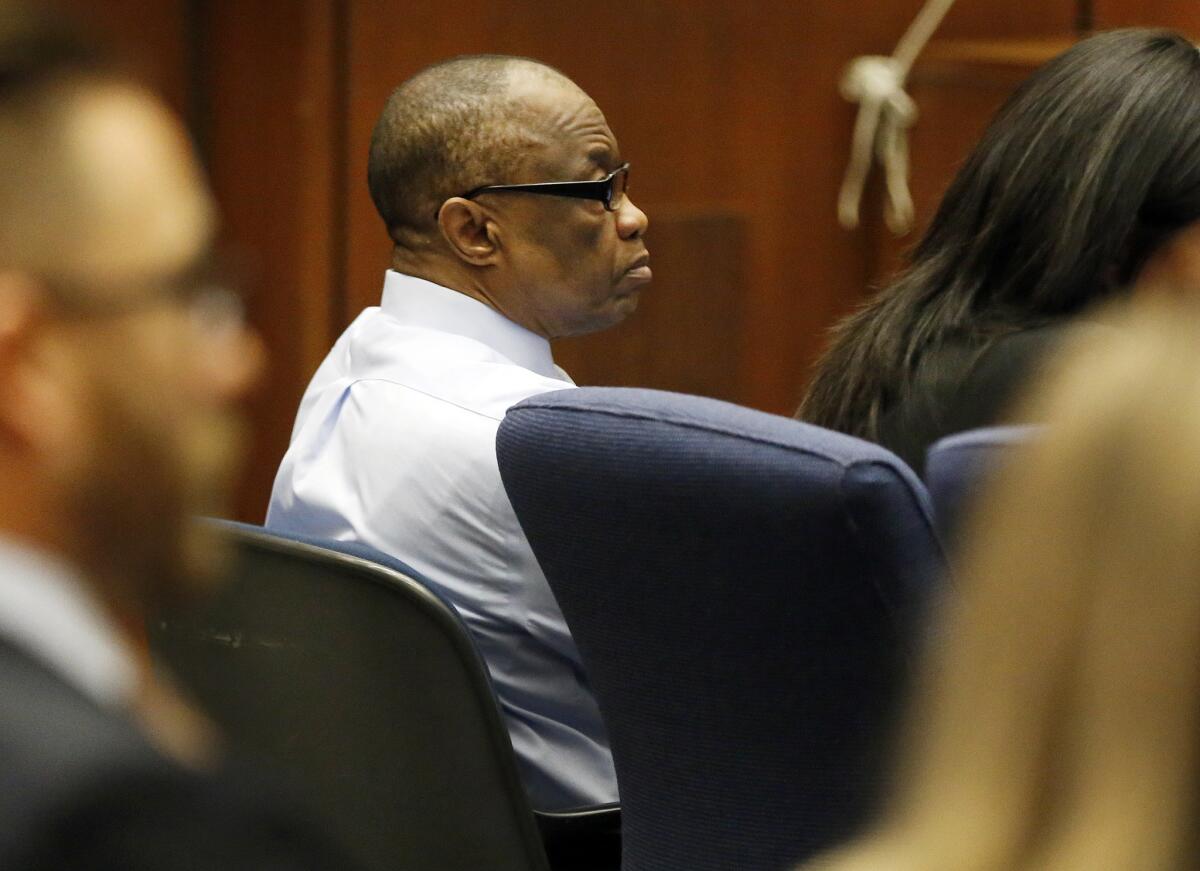Weapon in Grim Sleeper killing found in suspect’s dresser drawer, jurors are told

Lonnie Franklin Jr., shown in court in February, is charged with 10 counts of murder and one count of attempted murder.
- Share via
The gun was tucked inside a dresser drawer in the green house on 81st Street.
It was July 8, 2010, and scores of investigators scoured the home of Lonnie Franklin Jr., who was suspected in a series of killings of women in South Los Angeles.
LAPD criminalist Rafael Garcia testified Tuesday that down a hallway inside the home was a bedroom with blue walls, a twin bed and a black dresser. Clothes hung from a closet door.
He said he pulled out the top drawer from the dresser. What he discovered next would become a key piece of evidence in the case against Franklin.
Strewn amid cables and remote controls was an F.I.E Titan .25-caliber semiautomatic handgun, a loaded magazine and 10 loose bullets, Garcia said.
It was the gun prosecutors say was used to shoot 25-year-old Janecia Peters, who is believed to be the last victim of the Grim Sleeper serial killer.
Prosecutors say that Franklin, a former Los Angeles police garage attendant, killed Peters and others from 1985 to 2007. He is charged with 10 counts of murder, including that of Peters, and the attempted murder of another woman.
Franklin, 63, has pleaded not guilty.
Prosecutors have said that all the victims are connected to Franklin by DNA evidence, ballistics evidence, or both.
The search of Franklin’s home in the Manchester Square area of South L.A. took place a day after police arrested Franklin outside the house. An undercover team had retrieved a discarded slice of pizza and other items to analyze his DNA -- which was matched to genetic material found at some of the killing sites.
As Garcia testified in a downtown Los Angeles courtroom, photographs of the search of Franklin’s home were projected on a screen. In one photo, Garcia could be seen kneeling down, wearing a face mask and latex gloves and pointing at the weapon in the drawer. He later held the gun up for the jury.
The three-day search of Franklin’s home resulted in authorities collecting 800 items of evidence, including nine other guns.
The investigation was spurred three years earlier by the discovery of Peters’ body, found in a garbage bag inside a dumpster.
DNA retrieved from where she was killed matched that from the scenes of two earlier slayings, prompting investigators to begin matching the DNA with killings from the 1980s and more recent deaths up to the early 2000s, according to earlier testimony.
Investigators repeatedly tried to identify the common DNA they found at many of the killings. In 2008, officials checked the state’s DNA registry of offenders but came away empty-handed.
A year later, then-state Atty. Gen. Jerry Brown approved a new technique called a “familial search” that allowed officials to check whether a crime suspect’s DNA partially matched anyone in the state’s offender DNA database.
A new check came up with a partial match to Franklin’s son, whose DNA had been taken when he was arrested in 2008 and charged with firearm and drug offenses.
Investigators focused on Franklin and launched the surveillance operation.
MORE: Get our best stories in your Facebook feed >>
For more on the Grim Sleeper trial, follow @sjceasar.
ALSO
TV news reporter nearly hit by car while covering Bay Area train derailment
Killer of gas station attendant in Diamond Bar in 1994 may avoid life sentence
Six UC Santa Cruz fraternity and sorority members arrested in alleged Ecstasy ring
More to Read
Sign up for Essential California
The most important California stories and recommendations in your inbox every morning.
You may occasionally receive promotional content from the Los Angeles Times.














